Disclaimer and Caution: We are choosing not to name the zoo listed in the article. The Director who contacted us for help came on board at this zoo well after these problems existed, and he is doing his best to correct the issues. Please also note that this article contains images and video that you may find distressing.
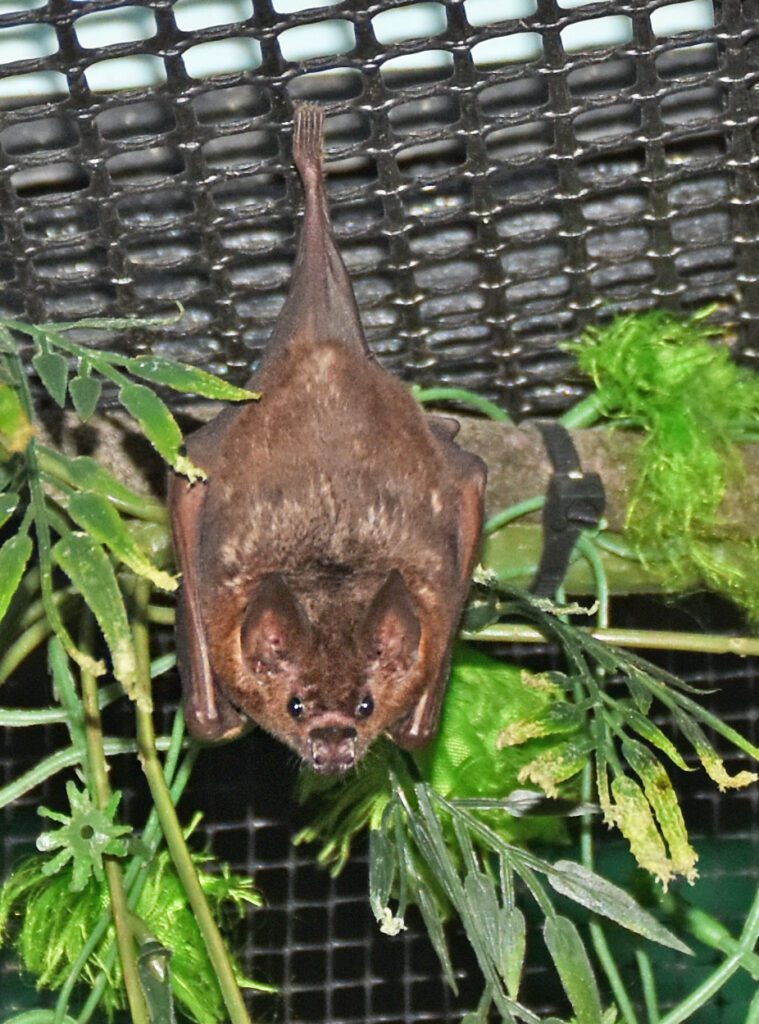
In February, we were contacted by an AZA zoo that has a large surplus of short-tailed fruit bats (the same species as our own Lil Drac). Unfortunately, the former directors of the zoo were allowing the bats to breed uncontrollably to the point where there were now thousands of unwanted bats. Sadly, surplus animals often wind up in the cruel, exotic pet trade and are then sold to the public, ultimately ending up in a birdcage in someone’s living room. When the new Director took over, he immediately realized that something had to be done. He began separating the males from the females as a first step to control the population. He then set out to find new homes for the females, which likely numbered 1,000 or more. Of course, many of these females were either already pregnant or were carrying young when they were separated. To make matters worse, short-tailed fruit bats are capable of delayed fertilization for up to one year.
The females were divided into several flight areas. The new Director reached out to other zoos, where some of these females were placed, but after one year of trying he was unable to find homes for the remaining 600. When he contacted us, he seemed desperate to place the remaining 600 females. Short-tailed fruit bats are extremely small, and they are very delicate emotionally. After much discussion, we agreed to take approximately 325 of these bats and the zoo agreed to provide for their food for the next three years, which we very much appreciate as that gives us the time needed to raise the funds for their future care.
These bats coming to us were in a flight area for over one year without being exposed to a male. In this period of time, there was little chance of any pregnancies due to delayed fertilization. It is critically important that we do not allow the bats to reproduce at our sanctuary as we would soon run out of the room required to accept bats in need, like these little girls. Still, when the bats arrived, we intended to check each individual to be sure the bats were all females.
The bats arrived on Monday, March 20th. They were driven to us by two dedicated zoo employees. They had traveled throughout the night for the 13-hour road trip to Bat World Sanctuary.
Upon arrival, when the back of the van was opened, we were shocked to see the crates in which the little bats had traveled. The bats themselves were inside metal mesh cages that were then placed inside wooden crates with the tops screwed shut. This meant there was no way to check on the bats in transit—no way to offer fresh food or water, and more importantly, no way to see if any of the bats were suffering from stress, or if they were injured, or otherwise in trouble
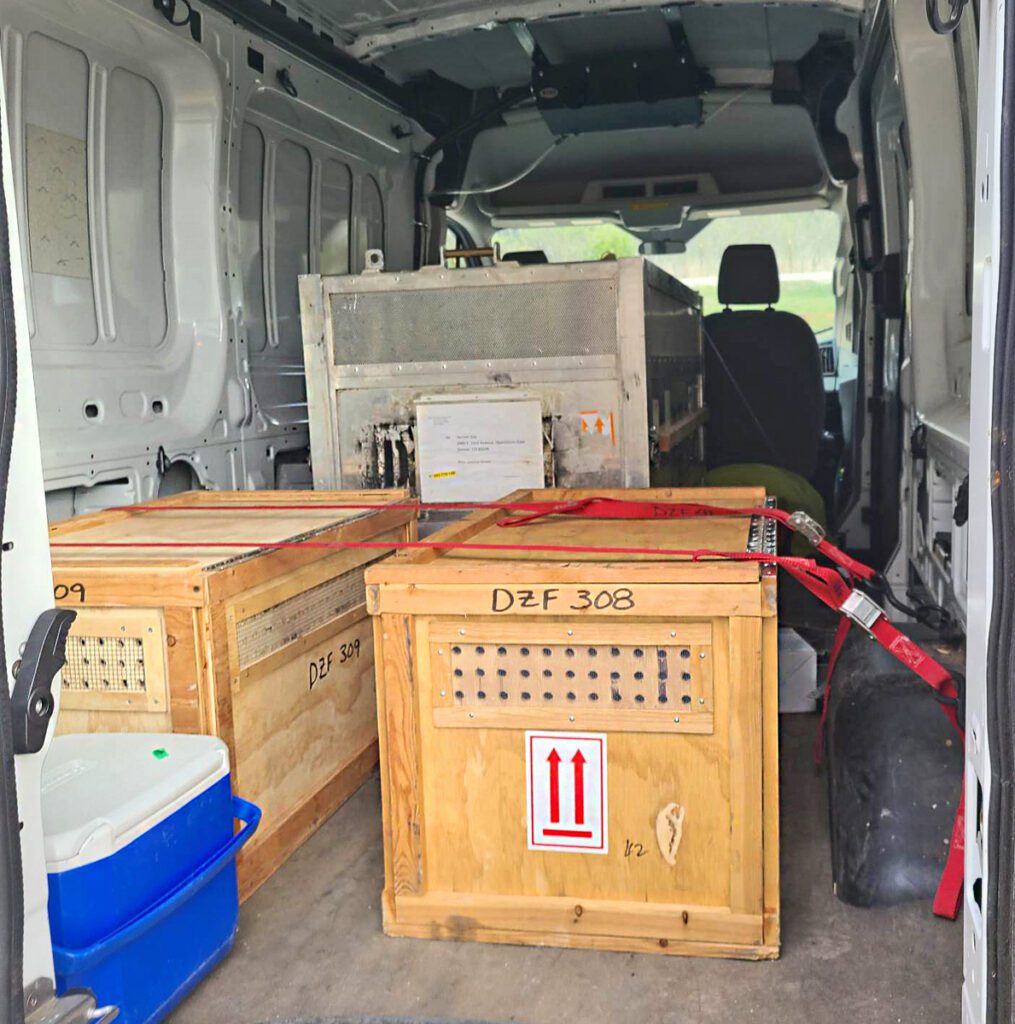
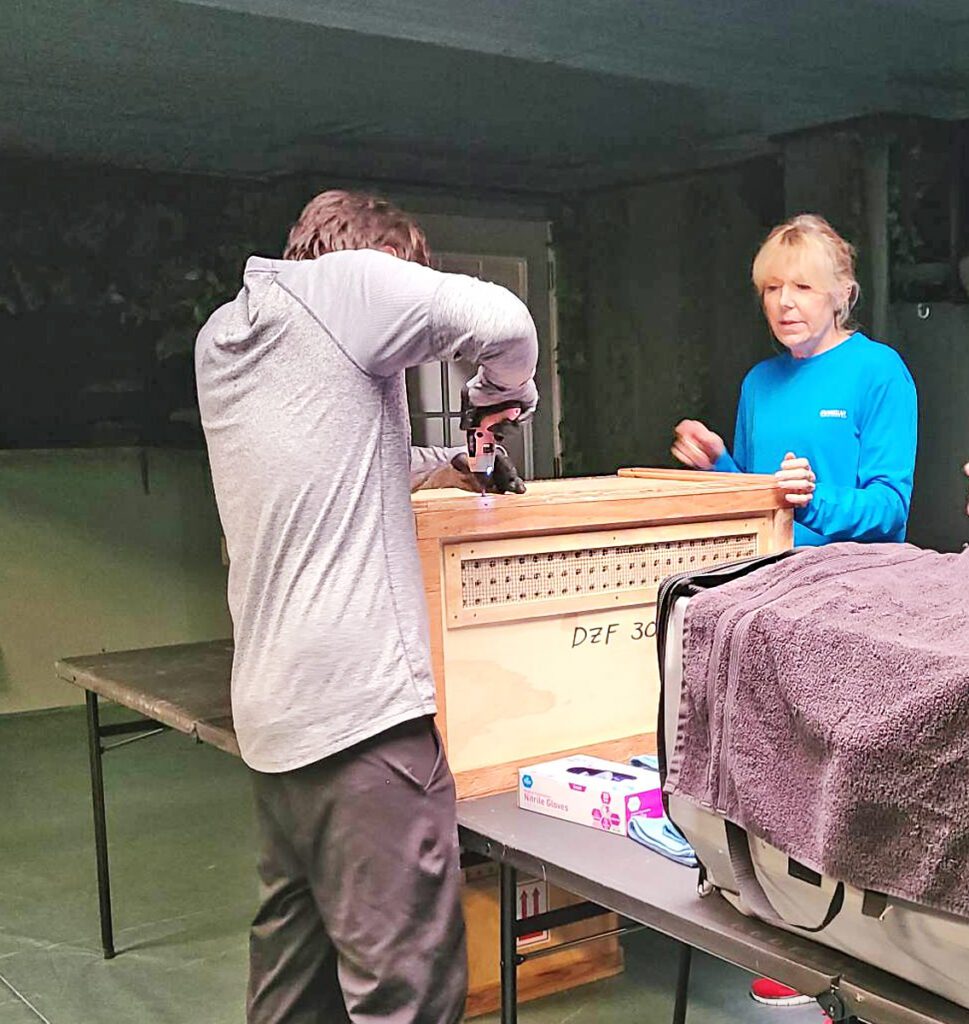
The crates in which these tiny bats were shipped. According to the zoo, bats are always shipped via IATA regulations (International Air Transport Association). Note that these regulations were created for shipping dangerous goods.
As the crates inside the building were opened, we were horrified to see the conditions inside the cages. There was no food or water, and many of the bats were pregnant. Some of these mothers had aborted their babies during the trip, and about a dozen females were in the process of aborting their pups as they were removed from the crates. Tiny fetuses were laying in a substance on the floor that resembled wet sawdust, although we were told by the transporters that it was actually food/gruel that had been dampened with water so the bats could eat it on the trip. Not only was this gruel covered in urine and feces, several deceased adult bats were stuck inside the mixture.
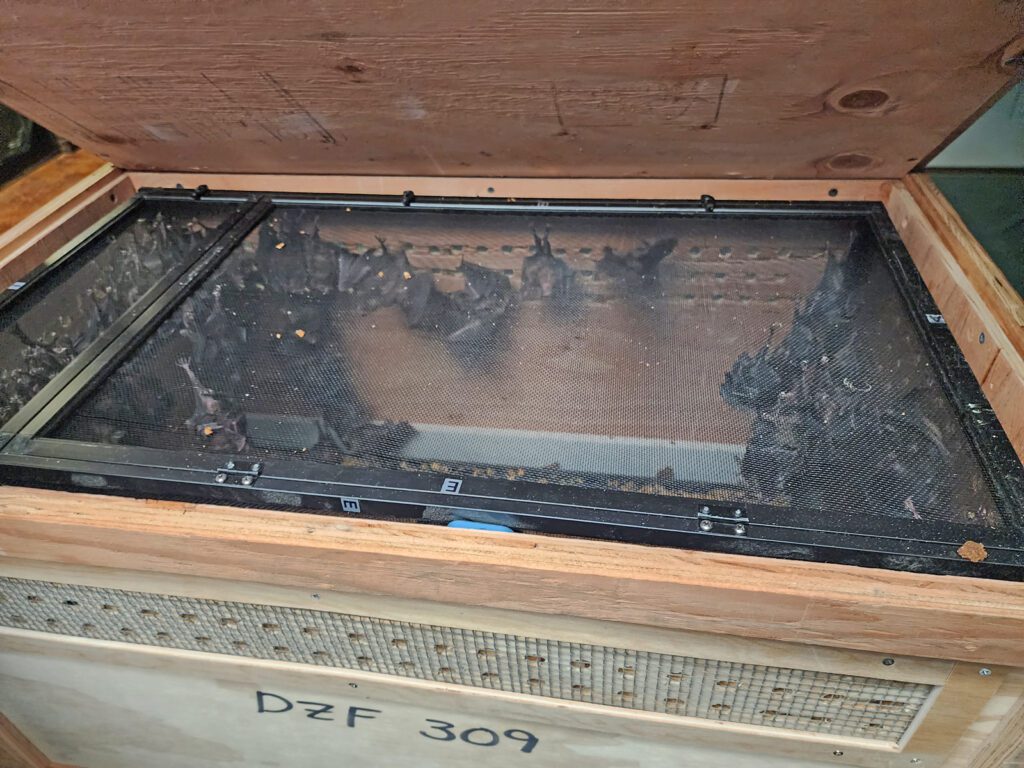
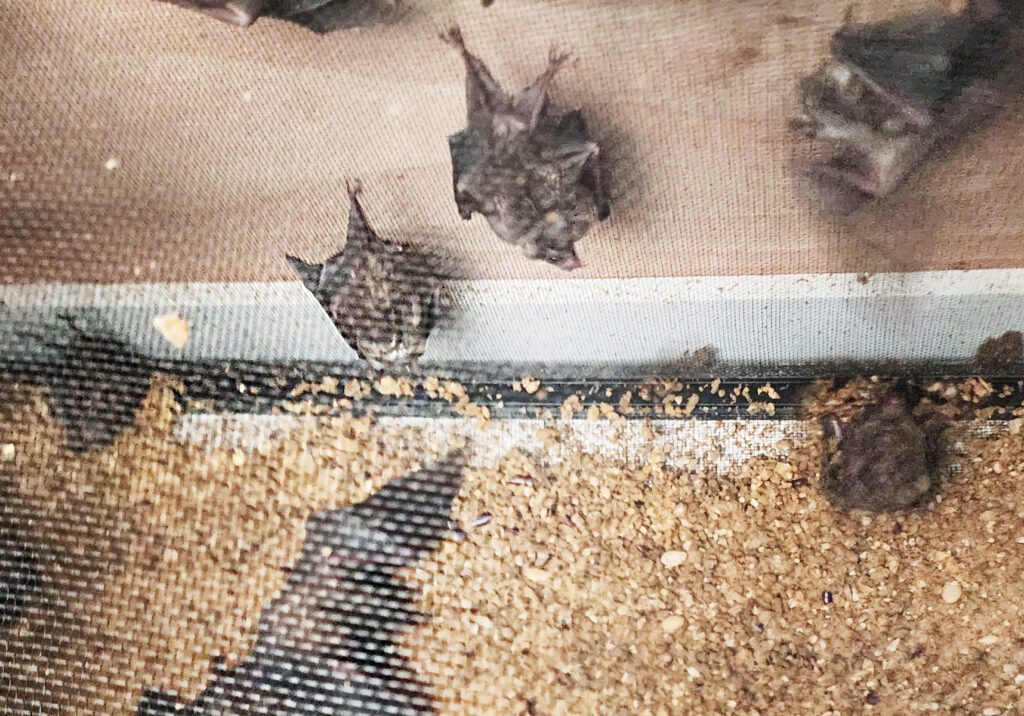
Left: Bats crowded at the lid desperately wanting to get out. Right: Bats on the floor, dead and dying, in their “food”
We attempted to remove the downed bats first, however, the active bats were starving and anxious to escape. Dozens and dozens were crowding the opening of the enclosure, making it difficult to remove the individuals in trouble. So, we placed dishes of fresh fruit on the floor of the crates in order to both give them much needed nutrition while also distracting them from the opening of the cage. When a dish of food was placed into their crates, the starving bats swarmed over the food so frantically that we quickly decided to pour large amounts of fresh food over the entire bottom of the cages to give them all a chance to eat. Thankfully, it allowed us the time needed to remove the downed bats more quickly.
Please note: the following footage is disturbing. It shows the frantic bats swarming over a dish of fresh fruit placed into their cage. When this happened, we stopped filming so that we could quickly provide more food.
We began a triage line in the sanctuary clinic. Seven staff and volunteers worked tirelessly over the next 12 hours, giving extremely cold and critical bats the care they needed in the form of warmth, emergency fluids, oxygen, and fruit juice to raise their blood sugar. Several bats were injured due to the wire mesh in the cage, this included broken wing fingers and abraded toes and thumbs. All of these bats are now receiving antibiotics and pain medication. They are being housed separately in our clinic so they can receive the daily care they need.
Sadly, 38 bats died during transport and 23 died over the next two days with an additional seven fetuses being found. We believe the adults who died were the pregnant bats who aborted and then failed to pass the placenta, which can cause sepsis very quickly in an animal with such a high metabolism.12
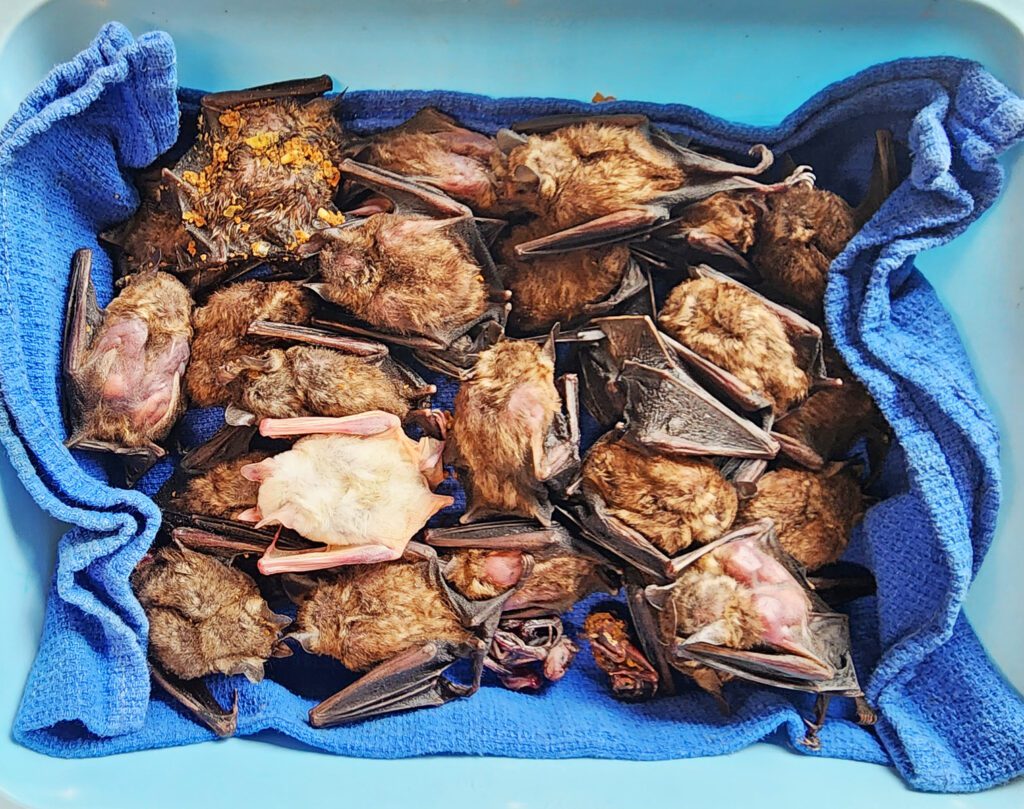
As of this writing the surviving 255 bats have stabilized. They are now roosting normally and are no longer landing on caregivers who enter the enclosure, frantically looking for food. They have gained weight and seem to realize that they will no longer have to fight each other for the basic food they need to survive. The bats who are still pregnant are also gaining weight and will be kept separated in a smaller flight enclosure until their babies are born. Any males who are born will be neutered when they come of age.
VIDEO OF RECOVERY AND RELEASE
Although the number of bats we received from the zoo seems large, we are fortunate in having the room to accommodate them due to their small size. Additionally, we are still working with the zoo to find homes for the remaining 300 bats and if needed, we are open to taking more of them after the appropriate amount of time has passed to allow the females who delayed fertilization, to birth their pups. The zoo has agreed to work with outside transporters so the bats can be safely and humanely transported to bonafide bat rescue centers in the future, via a bat care professional. One of these rescue centers, Pennsylvania Bat Rescue, has agreed to take 100 of these individuals. We are currently working with the center on raising the funds needed for a flight enclosure for PA Bat Rescue, which will be built to BWS specifications. PA Bat Rescue has also graciously offered to serve as a future rescue center to receive fruit bats rescued from the cruel, exotic pet trade in the North East. Individual and/or groups of bats will be transferred to us on a case-by-case basis.
While this story is both heart-wrenching and maddening, we are still grateful that the zoo retired these bats with us so they can have the life they have always deserved. However, this zoo is the exception to the rule. For most zoos, these tiny bats are seen as a commodity—disposable beings who only matter in large numbers for public viewing. With us, they will be treated as individuals whose lives are as important to them as ours are to us.
The practice of allowing bats to breed uncontrollably is allowed at most zoos solely so the public can see babies. Zoos must stop the devastating practice of creating ‘disposable’, surplus lives. Males should be neutered to prevent these types of catastrophes going forward, and bats should always be transported humanely. We have been campaigning for decades on the issue regarding overpopulation of bats in zoos. We have contacted both the USDA as well as the AZA on numerous occasions with little to no results.
We are now asking for your help. Your voices are powerful and matter greatly. The following list of AZA and USDA officials can make the changes needed for bats. Please write to the following individuals to voice your dismay at the way bats are treated in zoos.
- Kris Vehrs, AZA CEO
[email protected]
301-332-957 - Adrienne Rowland, AZA Board Chair
[email protected] - Lisa New AZA Board Chair-Elect
[email protected]
- Denise Verret AZA Vice Chair
[email protected] - Robert Gibbons, USDA
[email protected]and [email protected]
- Kris Vehrs, AZA CEO

